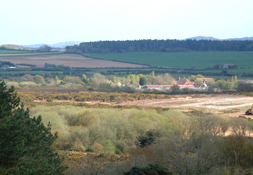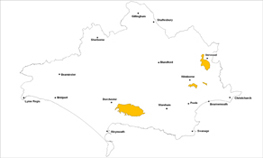Heath / farmland mosaic
Location
The Heath/Farmland landscape type is found largely on the fringes of the wider ‘Poole Basin’, an extensive area of former heathland on acidic and impoverished soils.
Key Characteristics
- mosaic of mixed farmland, heathland and scrub which creates a
patchwork landscape.
- generally flat landform, which drains to the adjacent river basins.
- heavily influenced and fragmented by urban and urban fringe land
uses such as industrial, commercial & leisure uses as well as
transport corridors, quarrying, power lines and ‘horsiculture’.
- some large areas of open heath and small fragmented pockets.
- straight roads and lanes often lined with thick hedges.
- mixed agriculture with some areas of estate farmland.
- woodland and plantations create key features, which helps to
integrate development.
- Winfrith Technology Centre creates an adverse impact
The Heath/Farmland Mosaic type is a transitional area between the
chalk landscapes, river valleys and other heathland landscape types.
It is generally a flat mixed farmed area interspersed with a mosaic of
heathland and scrub which all combine to create a patchwork landscape.
The farmed landscape does include some intensive estate managed
farmland where the medium sized fields have dense hedges and some
important hedgerow trees and small copses. There are some reasonably
expansive islands of open heathland such as at Winfrith Heath and
Tadnoll Nature reserve as well as smaller fragmented pockets across
the area. It is impacted on by transport corridors, mineral
extraction, other urban developments, such as recreational
/leisure/retail centres and urban fringe land uses which all fragment
the area creating a disjointed perception particularly in the east of
the county where the urban edges abut the landscape. Stand alone
settlements vary from picturesque villages such as West Knighton to
‘growth’ villages such Crossways. There are a number of important
elevated areas such as at Dudsbury Hill and Whitcombe Hill, which form
key local landscape features. The plantations and tree belts across
the area also form key features and do help to soften urban edges and
uses in places. The scale and prominence of Winfrith Technology Centre
near Wool creates a significant visual impact across a wide area.
Management Objectives
The overall management objective for the Heath/Farmland Landscape Type
should be to reduce heathland fragmentation, control and enhance urban
fringe uses and hard edges, manage and enhance al existing tree belts
and promote informal recreation.
Key land management guidance notes
- consider opportunities to reduce heathland fragmentation by
carrying out appropriate heathland restoration/creation for example
by the phased removal of wood/scrub/forestry which is of minimal
visual benefit in screening unsightly uses and/or that which has
little biodiversity value.
- maximise opportunities for informal recreation in areas of woodland.
- promote heathland grazing management.
- manage and enhance existing conifer & broadleaved tree belts,
which help to screen and integrate urban uses.
- soften hard and intrusive urban and urban fringe edges to reduce
their landscape and visual impact e.g. through small scale
broadleaved native planting and/or via natural regeneration.
- promote/encourage/enforce enhancement to the setting of selected
mineral excavations and operating plants and in particular their
access points onto highways.
- maintain and enhance area as a physical open space area between
sensitive heathland habitats and urban/suburban areas.
- control and manage urban fringe uses such as ‘horsiculture’ to
reduce their landscape and visual impacts e.g. through careful
design & site planning, planning policy development and/or
voluntary codes of practice.
- promote/encourage the production of a comprehensive Landscape
Design/Management Restoration Masterplan for Winfrith Technology Centre.
Landscape Character Assessment Map
View a map of all the Landscape Character Areas in Dorset, or view a list


